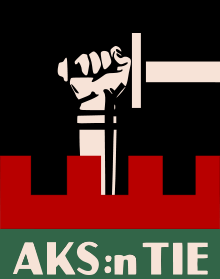Academic Karelia Society

The Academic Karelia Society (Akateeminen Karjala-Seura, AKS) was a Finnish elitist nationalist and Finno-Ugric activist organization aiming at the growth and improvement of newly independent Finland, founded by academics and students of the University of Finland in 1922. Its members retained influential positions in the academic life of the era as well as within the officer corps of the Army. The AKS controlled the student union of the University of Helsinki from the mid-1920s right up to 1944, when the Society was disbanded in the aftermath of the Continuation War that to a great extent had been planned and fought in accordance with the AKS agenda.
Ideological roots
The political and philosophical ideology of the AKS had its main roots in the philosophy of the 19th century Fennophile statesman Johan Vilhelm Snellman who emphasized a strong national state and the need of bringing the Finnish language into the forefront of the Finnish cultural life, which was dominated almost exclusively by the Swedish language.
The nationalistic ideology of the AKS also stemmed from the common European discussion of national rights based on the 14 points of President Wilson. Also the experience of the Finnish Civil War bolstered a deep anti-socialist sentiment in the Finnish nationalist circles of that time. One of the slogans the AKS used was "Pirua ja ryssää vastaan!" (Against the devil and the Ruskies!) where the devil is referring to the Society's main domestic enemies, the socialists and communists. Despite holding views close to the Fascist movement of Italy, there was no influence from abroad - the AKS was founded before the Fascist march on Rome and its origins were purely domestic. The group was founded by Elias Simojoki, Erkki Räikkönen and Reino Vähäkallio.
Karelia
Many of the founders of the AKS were veterans of the Karelian wars and thus had knowledge of the plight of the Karelian-speaking population in Soviet Karelia. The Karelians were considered to be a part of the Finnish heimo (folk) and their fate was of utmost importance for the AKS. The Academic Karelia Society's program was centered around their main demand: the acquisition of East Karelia from Soviet Russia and the liberation of the Karelian kinfolk. The work towards this goal was mainly done by propagandist efforts to keep the matter in the public eye.
AKS also organized aid to Finnic minorities in Soviet Russia and refugees from there and promoted cultural efforts to help the Finnish-speaking minorities of northern Sweden and Norway. They also tried to cultivate friendship between the newly independent states of Finland and Estonia (and, to a lesser degree, Hungary).
Domestic policies of the AKS
Domestically the AKS was an emphatic proponent for a strengthened army and for strict restrictions against Socialists, although it at the same time stressed the need of improving the lot of the working classes in the interest of the national community. It also promoted the rights of the Finnish language to become the first language in the country, especially in the Universities and in the bureaucracy of the state. Initially the group was ambiguous to democracy but under the chairmanship of Vilho Helanen it came to oppose the concept.[1]
In the 1930s, the AKS was an ally of the ultra-right Patriotic People's Movement party. AKS also maintained close ties with a militant secret society called Vihan Veljet. Some authors claim that Vihan Veljet was actually a group inside the AKS, not a separate organization, but there is not much evidence either way.
Legacy of the AKS
After the end of World War II, the organization was labeled "fascistic" and officially disbanded on the order of the Allied Control Commission, and the archives of AKS were hidden or destroyed.
Prominent former members include quite a few academics, bishops, business leaders, generals and politicians (e.g. president Urho Kekkonen). Many officers of the Finnish army during the wars of 1939–1940 and 1941–1944 were members of the Society.
References
- ↑ Philip Rees, Biographical Dictionary of the Extreme Right Since 1890, 1990, p. 176
- Eskelinen, Heikki. (2004), "Me tahdoimme suureksi Suomenmaan". Akateemisen Karjala-Seuran historia I, English summary p. 382-385. WS Bookwell Oy.